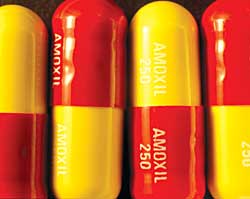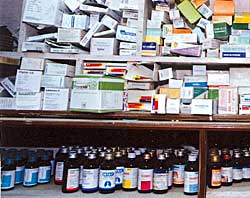 Two of the world's leading producers of counterfeit pharmaceuticals are Nepal's neighbours to the north and south. Fake and substandard medicines are widely sold in the Nepali market, but regulators, traders and the public don't seem to realise the enormity of the problem.
Two of the world's leading producers of counterfeit pharmaceuticals are Nepal's neighbours to the north and south. Fake and substandard medicines are widely sold in the Nepali market, but regulators, traders and the public don't seem to realise the enormity of the problem. Last month, the Department of Drug Administration (DDA) seized 1,200 capsules of the antibiotic amoxycillin 250mg from three pharmacies in Rupendehi district. The manufacturer was listed as Adip Labs of Kalol in India, but inquiries revealed that no such company exists. The capsules only contained a white odourless powder that was not an active ingredient.
What makes the seizure in Rupendehi interesting is that amoxycillin is one of the most-commonly prescribed antibiotics to counter infections and Rs 260 million worth of amoxycillin is sold in Nepal alone every year. What was caught is clearly the tip of the iceberg.
Seventy percent of Nepal's annual Rs 8 billion pharmaceutical demands are met by Indian imports. Domestic production accounts for 27 percent and the rest come from other countries. The World Health Organisation estimates that 35 percent of the fake drugs produced in the world come from India, where about 20 percent of all drugs sold are either fake or substandard.
The US Food and Drug Administration estimates that about 10 percent of all drugs around the world are counterfeit and 60 percent of them are found in developing countries. Indian fake medicines have made their way into the African market, including in Kenya and Nigeria (see box).
What worries consumer groups here is that the manufacture and sale of fake drugs is so prevalent in India, with which Nepal shares an open border. They say our monitoring and regulation systems aren't vigilant enough to meet this danger.
Doctors interviewed for this article say the lack of monitoring is compounded by lax enforcement of prescription rules. Antibiotics are readily available across the counter in Nepal. Fake, substandard and deficient dosages are creating a danger of drug resistance. The impact of this on tuberculosis and Acute Respiratory Infections could have a catastrophic impact in the future, when antibiotics prove ineffective for drug-resistant patients. TB treatment in Nepal is already hobbled by multi-drug resistant strains of the TB bacillus.
But the government plays down the extent of the problem. Bhupendra Bahadur Thapa, acting director general at the DDA says: "The counterfeit drug problem in Nepal is minimal. We have found only 3-4 cases of fake medicines in the past 15 years." The reason is that only licensed importers are officially allowed to bring in drugs from India before they are sold to retailers. However, he admits there is a problem in the tarai because of smuggling.
According to Indian media reports, fake drugs are mainly manufactured in Punjab, Haryana, Bihar, Uttar Pradesh and Himachal Pradesh. Two of these Indian states border Nepal. The counterfeiters copy blister pack designs and even provide fake holograms on the packages. Fictitious batch numbers and dates of import can be made by fly-by-night outfits in Mumbai on letterheads of well-known pharmaceutical firms for exports.
Consumer groups and doctors in Nepal say the only reason the DDA has found so few cases of counterfeit drugs in Nepal is because of poor and irregular monitoring. The only way to tell a if medicine is fake or substandard is to do a lab test. Since the problem is so vast, not all consignments can be spot-checked. Unscrupulous druggists can therefore easily buy fake drugs from smugglers at a lower prices and then sell them at the full price and triple their profit margins.
The government's current regulation only allows companies certified by WHO's Good Manufacturing Practice (GMP) to bring medicines into Nepal. The DDA provides licenses to these companies after auditing them and also sends out inspection teams, as it did last month to Mumbai, Chennai and Bangalore.
There are currently 272 Indian and 38 domestic companies registered with the government, selling about 8,000 brands of medicine. Only two Chinese manufacturers are registered with the DDA, and the threat of fake Chinese medicines is said to be less because most doctors prescribe Indian brands and the Chinese ones are less in demand.
While counterfeits of well-known brands contain no ingredients of the original product, substandard drugs are either diluted or don't meet the standards prescribed in a country's pharmacopoeia. Adulteration, leaking and medicines past expiry dates or with the wrong proportion of ingredients are some of the reasons why drugs are substandard.
In last month's raids on pharmacies, the DDA found druggists in Narayanghat, Butwal and Krishnaagar with 11 brands of unlicensed medicines and collected 18 dubious samples of substandard drugs. Thapa says that of the total number of samples collected, only three percent were found to be substandard after tests at the Royal Drugs Laboratory. The DDA's main complaint is lack of manpower: it has only eight inspectors and has to make 400 laboratory tests per year.
One of the inspectors,Baburam Humagain, estimates that up to 20 percent of the drugs in the market are substandard. In a batch of spot tests last year, 96 out of 359 samples of medicines (expired Thiabric, Antozol, Omiprazol capsules and Norifloxacin) were found to be substandard.
Ashok Sharma of the Nepal Pharmaceutical Producers Association says the DDA is doing a good job despite constraints, but admits that chemists and the public should also be vigilant. "Once they are tipped off, the DDA can take action against the culprits," he says.
The DDA seems to have realised that the main conduit for fake drugs is India, and in an effort to control smuggling has limited the transit for imported drugs to only nine points, including Kathmandu airport, Tatopani and points along the tarai.
 . Fake medicines are concoctions with wrong ingredients or incorrect quantities of active ingredients or products without any active ingredients at all
. Fake medicines are concoctions with wrong ingredients or incorrect quantities of active ingredients or products without any active ingredients at all . It is virtually impossible to differentiate between real and counterfeit medicines without proper testing
. Nearly 10 percent of the global pharmaceutical commerce is attributed to fake drugs. In India it is at 20 percent and in Nepal it is probably more
. Combating this menace should be a shared responsibility
Nigeria's fake drug mafia
LAGOS-Nigeria's fearless crusader against fake drugs, Dora Akunyili, was awarded the Transparency International Anti-Corruption Award last year for battling the scourge of fake pharmaceuticals in her country.
But this is not protecting her from harassment and intimidation from the fake drug mafia in her country. This week, there were arson attacks on two buildings that house Akunyili's National Agency for Food and Drug Administration Control (NAFDAC) and last month she received death threats.
On Wednesday, the Kaduna office and laboratory of NAFDAC was gutted by fire and barely 72 hours earlier, NAFDAC's office in Lagos had also burned down when the Federal Government Secretariat building caught fire. The fires were believed to have been started by dealers in counterfeit drugs who are being targeted by NAFDAC.
In December, an attempt was made on Akunyili's life at her country home in Agulu, eastern Nigeria. Sixteen people implicated in the assassination bid were later arrested, according to Nigerian police.
"The arson attacks will not deter us from waging the war against fake drugs. I can assure Nigerians (that) we shall win the war, because we know we are fighting for the common man," said Nnamdi Ekweogwu, Director of Administration and Finance at NAFDAC.
Nigeria's fake drug market is estimated to be worth $60 million a year, and most of the spurious medicines come from India and China. Akunyili's own sister died after a fake medication was ineffective in controlling an infection she had four years ago.
NAFDAC wants Nigeria to start domestic production of most medicines within the next decade, to eliminate the import of fake products into the country. (IPS)


